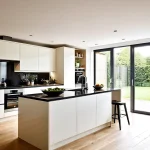The role of kitchen layout in enhancing cooking efficiency in compact UK spaces
In compact UK kitchens, the kitchen layout directly shapes cooking efficiency by optimizing workflow and maximizing available space. Given the limited footprint of many British homes, a well-planned kitchen layout minimizes unnecessary movement and ensures all key areas—cooking, preparation, and cleaning—are easily accessible.
Two of the most common kitchen layouts in the UK are galley and L-shaped designs. The galley layout, characterized by parallel countertops, excels in narrow spaces, allowing cooks to move swiftly between cooking surfaces and storage. The L-shaped layout, meanwhile, offers greater flexibility by opening the kitchen to an adjoining room or dining area, enhancing both space utilization and social interaction.
Have you seen this : Exploring the impact of space-saving furniture in compact uk kitchens
Layout choices impact daily cooking tasks profoundly. For example, a galley kitchen enables efficient meal prep but might limit space for multiple users, whereas the L-shaped layout supports more than one person cooking simultaneously, improving workflow. Thoughtful placement of appliances and work zones according to these layouts can reduce clutter and streamline kitchen tasks, ultimately enhancing cooking efficiency.
By designing around these core layout principles, compact UK kitchens can transform restrictions into opportunities for smoother, more enjoyable cooking experiences.
Also read : Mastering compact kitchen design: tips for achieving balance in small uk homes
Space-saving strategies tailored to compact UK kitchens
In small kitchens UK homeowners face unique challenges, making space-saving tips essential for maximising efficiency. One of the most effective strategies is integrating multifunctional furniture. For example, foldable tables or island units with built-in storage can unlock valuable floor space without sacrificing utility. This approach helps you do more with less.
Decluttering plays a crucial role as well. Minimising items stored on countertops immediately creates an impression of openness. Consider investing in organizers that keep everyday tools neatly tucked away yet easily accessible. This not only optimises counter space but also reduces visual chaos, improving workflow.
Vertical storage is another game changer. Utilizing wall-mounted racks, magnetic strips, and open shelving draws the eye upward, freeing cupboards and drawers. Open shelving offers the added benefit of quick access to frequently used objects, fostering convenience and efficiency. By embracing these space-saving tips, your compact kitchen can feel larger and function better, making daily cooking more enjoyable and less stressful.
Comparative analysis of popular kitchen layouts for UK homes
When choosing between a galley kitchen and an L-shaped kitchen, understanding their advantages is crucial. The galley kitchen features two parallel counters, optimizing workflow by keeping everything within easy reach. This layout’s compact nature makes it ideal for narrow UK homes or flats where space is tight. However, it can feel cramped if used by more than one person simultaneously.
In contrast, the L-shaped kitchen offers more open space by situating counters on two adjoining walls. This design enhances accessibility and flexibility, accommodating multiple users more comfortably. The open plan also allows for additional dining or storage areas, making it suitable for slightly larger rooms.
From an efficiency standpoint, galley kitchens excel because they reduce walking distance between the stove, sink, and fridge. Meanwhile, the L-shaped layout supports a smoother flow, especially in homes where cooking and socializing happen together.
For very compact spaces common in UK housing, galley kitchens maximize use of limited floor area but may sacrifice openness. L-shaped kitchens provide a balance between efficiency and space, adapting well to small or medium kitchens with corner layouts.
Selecting the best kitchen layout depends on room dimensions, household needs, and lifestyle habits. Both layouts can be tailored effectively to UK homes by prioritizing ease of movement and practical storage solutions.
Real-life examples demonstrating efficient kitchen layouts
Exploring kitchen layout examples from compact UK homes reveals how space can be maximized without sacrificing style or functionality. For instance, one popular approach is the use of a galley kitchen layout, where two parallel counters create an efficient work triangle. This design minimizes movement between the sink, stove, and fridge, crucial in smaller spaces.
In another UK kitchen design case study, an L-shaped layout incorporates wall-mounted storage and fold-away counters to exploit vertical space. The integration of slimline appliances and deep drawers transforms limited square footage into intuitive storage zones. Such adaptations address common challenges like narrow floor areas or limited natural light.
Additionally, some compact kitchens employ open shelving combined with glass cabinet doors, lending a sense of openness while maintaining accessibility. These layouts demonstrate how innovative space planning caters to individual needs, adapting to irregular room shapes or integrating kitchen islands that double as dining tables.
Overall, these compact kitchen case studies underscore that success lies in blending ergonomics with creativity, proving that well-thought-out layouts can elevate even the smallest UK kitchen into a highly efficient and enjoyable workspace.
Actionable design strategies for maximizing efficiency in small UK kitchens
Smart approaches to transform your compact space
Maximizing efficiency in compact spaces UK demands tailored design strategies, particularly in small kitchens where every inch counts. The first essential step is assessing your daily kitchen habits to adapt the layout accordingly. For example, creating designated zones for cooking, cleaning, and storage based on usage frequency can streamline movement and reduce time spent searching for utensils.
Taking into account typical UK constraints—such as smaller room sizes and building regulations—design strategies often involve vertical storage solutions. Installing high cabinets or open shelving utilizes unused wall space, freeing up the limited countertop area crucial for meal preparation. Incorporating built-in appliances and multi-functional furniture also serve to optimise space without sacrificing functionality.
When planning an efficient kitchen redesign, begin by mapping out current workflow bottlenecks and prioritising changes that address these. Practical steps include choosing lighter colours to visually enlarge the space, installing task lighting to enhance usability, and opting for sleek, handleless cabinetry to avoid clutter. Implementing these design strategies can dramatically improve both aesthetics and performance in your small UK kitchen, ensuring a practical, enjoyable cooking environment tailored to your needs.


